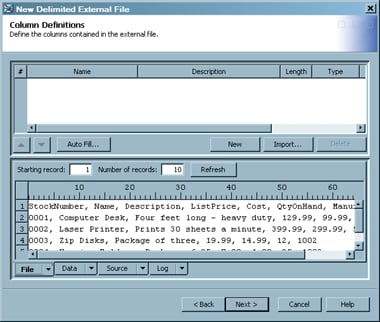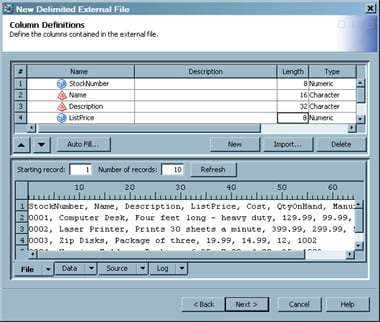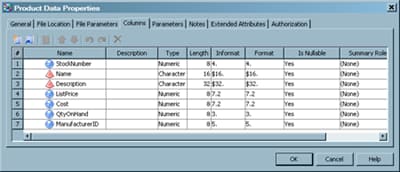Registering a Delimited External File
Tasks
Run the Delimited External File Wizard
Perform
the following steps to use one method to register an external file
in the delimited external file wizard:
-
Right-click the destination folder for the external file metadata. Then, select New
 External File
External File Delimited to access the General
page in the New User Written External File wizard. Enter an appropriate
name and description of the external file that you want to register.
Click Next to access the External File Location
page.
Delimited to access the General
page in the New User Written External File wizard. Enter an appropriate
name and description of the external file that you want to register.
Click Next to access the External File Location
page.
-
The first row in most external files is unique because it holds the column names for the file. Therefore, you should change the value that is entered in the Start record field in the Guessing records group box to
2. This setting ensures that the guessing algorithm begins with the second data record in the external file. Excluding the first data from the guessing process yields more accurate preliminary data. -
Select the Get the column names from column headings in the field radio button, and keep the default settings for the fields underneath it. Click OK to save the settings and return to the Column Definitions page. The names from the first record in the external file are populated in the Name column. You now can edit them as needed.Note: If you use the get column names from column headings function, the value in the Starting record field in the Data tab of the view pane in the Column Definitions page is automatically changed. The new value is one greater than the value in the The column headings are in file record field in the Import Column Definitions window.
-
The preliminary metadata that is populated into the columns component usually includes column names and descriptions that are too generic to be useful for SAS Data Integration Studio jobs. Fortunately, you can modify the columns component by clicking in the cells that you need to change and entering the correct data. Enter appropriate values for the external file that you are registering. The following display depicts a sample completed Column Definitions page.
-
To verify that the metadata you have entered is appropriate for the data in the external file, click the Data tab and then click Refresh. If the metadata matches the data, the data is properly displayed in the Data tab. The Data tab looks similar to the View Data window for the registered external file. If the data does not display properly, update the column metadata and click Refresh to verify that the appropriate updates have been made. To view the code that is generated for the external file, click the Source tab. To view the SAS log for the generated code, click the Log tab. The code that is displayed in the Source tab is the code that is generated for the current external file when it is included in a SAS Data Integration Studio job.
View the External File Metadata
After
you have generated the metadata for an external file, you can use
SAS Data Integration Studio to view, and possibly make changes to,
that metadata. For example, you might want to remove a column from
a table or change the data type of a column. Any changes that you
make to this metadata do not affect the physical data in the external
file. However, the changes affect the data that is included when
the external table is used in SAS Data Integration Studio. Perform
the following steps to view or update external file metadata:



